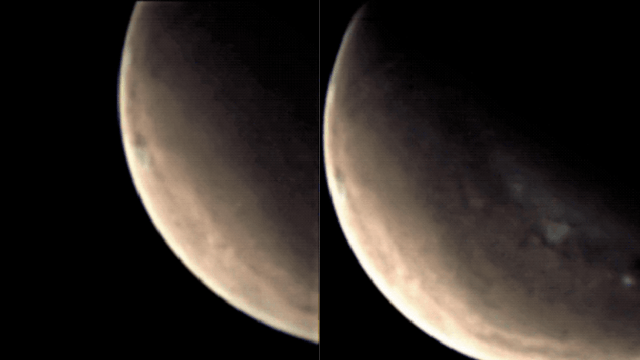To commemorate the 20th anniversary of the Mars Express Orbiter, the European Space Agency broadcast the first-ever Mars livestream, in a historic event that unfolded over an hour on Friday, June 3. A newly released animation shows a sped-up version of how the livestream unfolded.
During the live stream, images arrived once every 50 seconds, as the orbiter’s onboard Visual Monitoring Camera (VMC) captured the photos from Mars orbit. There is, unfortunately, a discernible gap in the middle, the result of rain at ESA’s ground station in Cebreros, Spain, which disrupted telemetry from the orbiter. Engineers are still in the process of trying to recover the missing images, according to an ESA press release.
The experiment exposed some neat Martian features, including atmospheric phenomena.
“Mars is now approaching the southern winter season,” VMC team member Jorge Hernández Bernal explained in the same press release. “The South Polar cap is apparent in these images, close to the polar night, while the Arsia Mons volcano is present on the left side of the planet. Orographic clouds are also common during this season, and form as the atmosphere flows up mountains and volcanic slopes.”
On the right side of the video, a different cloud is observed in proximity to the polar cap, Bernal added. The team conducted a comprehensive study of these high-altitude clouds during twilight using the VMC, revealing their prevalence in this particular region of the planet during this season.
Achieving this milestone proved to be a big task, as the VMC needed a view of the planet at the same time that the orbiter’s antenna was continuously facing Earth in order to immediately stream the data home. Ordinarily, observations are stored onboard the spacecraft and transmitted in a batch to Earth, which can take hours and even days.
“Usually, it’s not possible to point the spacecraft’s instruments at Mars and the communications antenna at the Earth at the same time,” James Godfrey, Spacecraft Operations Manager for Mars Express, said in the press release. “But some weeks ago, when we were looking for ideas on how to celebrate the anniversary, we realised that Mars would pass through the field of view of VMC during a communications pass and the idea was born.”
These aren’t the most spectacular visuals we’ve ever seen of Mars, but this experiment does give us the sense that we’re increasingly bridging the gap between Earth and the Red Planet.
